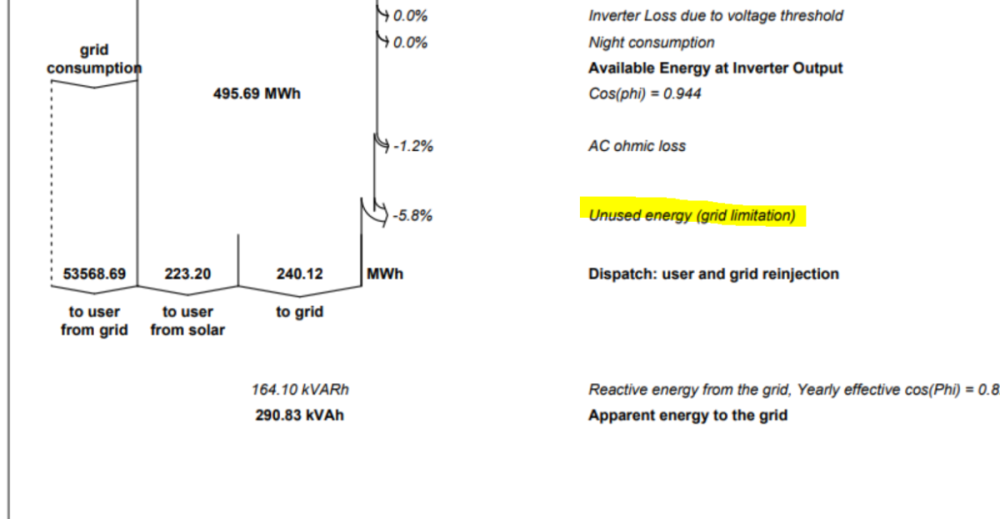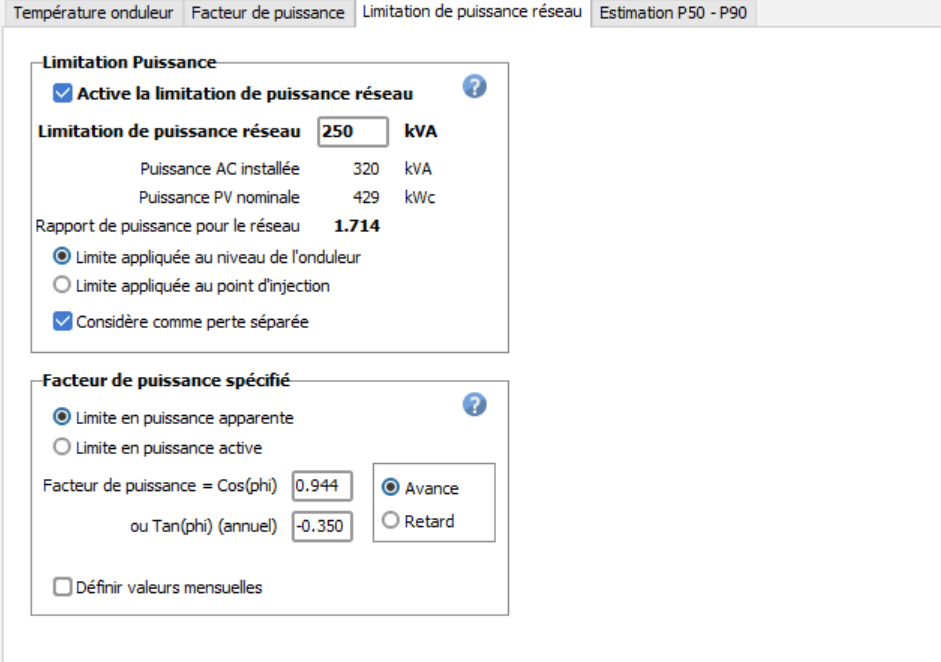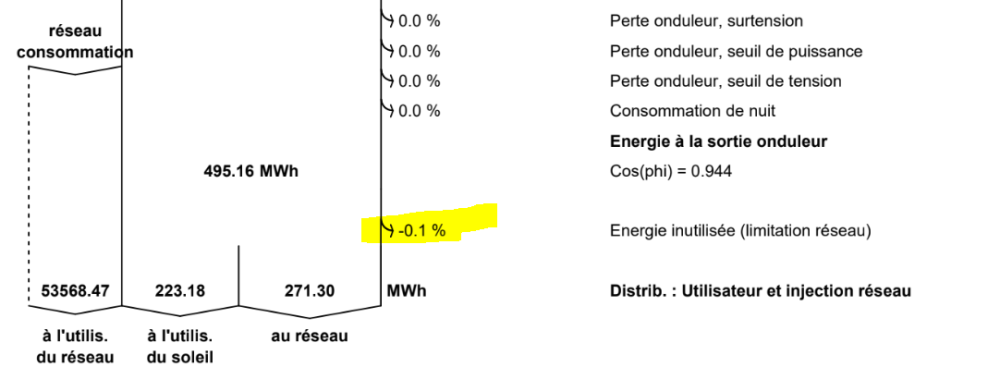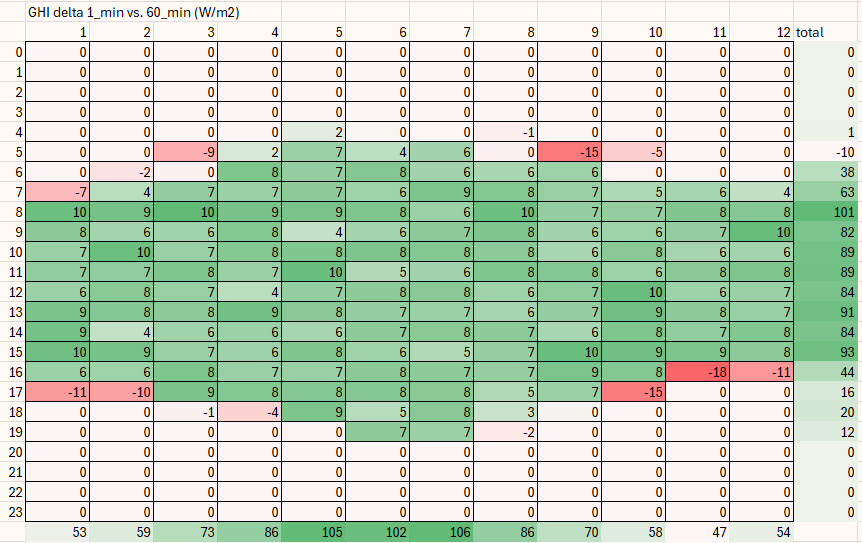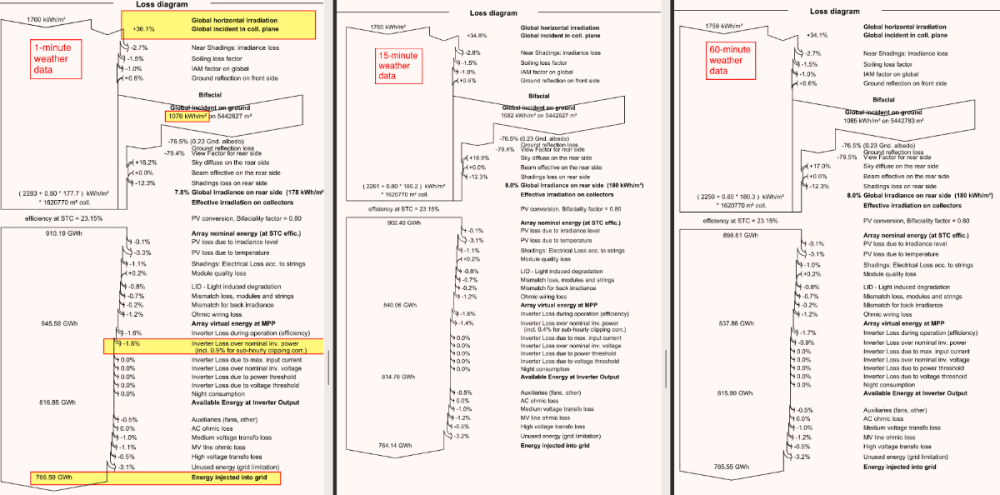All Activity
- Past hour
-

Inquiry on Simulating PV Façade Installations in PVsyst
Linda Thoren replied to Sara's topic in How-to
Hello, The available area in the Pre-sizing help in the System window, serves as a guide for a first order of magnitude of how many panels you can fit on a dedicated surface. This tool take only the size of the panels into consideration (not the spacing between the panels or a pitch). If no 3D scene is defined, no configuration other than what is defined in the system and orientation window is considered (no shadings). Defining a 3D scene with the surrounding shading elements, include electrical shading definition etc. will more accurately simulate the system. You find a tutorial for the 3D tool in the following link: Another potential important parameter for a vertical system would be the reflection on the ground. For a monofacial system, this is discussed in the following forum page: - Today
-
Hi, From the information you provided, this behavior does not seem normal indeed. The 1st graph looks ok, having 5.8% losses due to the grid limitation with 320kVa installed and 250kVa does not strike me as unusual. The fact is has been lowered to almost nothing in the second case is strange. I tried to reproduce your test case, but the results I obtain are correct. Please contact support@pvsyst.com and share your project so we can have a better look at what's happening.
-
André Mermoud started following Hybrid systems and Hybrid System
-
You can add a battery in your database from scratch by using "Databases => Batteries => New". But you are strongly advised to choose a similar battery in the database, modify its parameters according to your own component datasheets, and save this as a new battery. For defining an hybrid system, you should choose the button "Storage" in the project's dialog, and probably choose the option "Self consumption" for your case.
-
I would like to inquire about the correct procedure for simulating PV façade installations in PVsyst. I have specified the available façade area and set the tilt angle to 90°, but I am uncertain how the software interprets this configuration. Does PVsyst arrange the panels vertically on a single flat surface (side by side), or are they positioned one behind another? Additionally, is there an alternative or more accurate method to simulate façade-mounted PV systems in PVsyst?
-
No, in the present time PVsyst doesn't consider the charging of the battery from the grid.
-
Sara joined the community
-
Muhammad Aqib joined the community
-
Lazare Fesnien started following Simulation Using Microinverter
-
We update the database using the requests of the manufacturers, and publish it with each new release of PVsyst. We can't of course follow all the new products of all manufacturers in the world. We don't want to include data without the acknowledgement of the manufacturer. Nevertheless you can easily create your own components by yourself. The easiest way is to choose a similar existing device in the database, modify its parameters according to the manufacturer's datasheets, and save it under a new name, therefore creating a new file in your database. You have a tutorial for that on youtube: https://www.youtube.com/c/PVsystTutos. The inverter database already includes microinverters.
-
Hi. How can I run a simulation using a microinverter? Also, how can I include a microinverter in the database? Thank you.
-
Ephraim joined the community
- Yesterday
-
Mickael BLEIN started following Unused energy (grid limitation)
-
Dear PVSYST Support, I have a question about the grid limitation in PVSYST. Indeed, in my simulation, I put the grid limitation at 250 kVA this way with AC ohmic loss =3% And the result is -5.8% of unused energy. It seems very huge and the impact on the productible is very strong. I did the same simulation with 0% Ohmic loss, and the result of unused energy is -0.1% How is calculated the Unused energy ? It seems that the more you have ohmic loss, the more you have Unused energy due to grid limitation. It's not logical for me. Do you have more informations about this please ? Thanks a lot Sincerely Mickaël BLEIN
-
Mickael BLEIN joined the community
-
Abeer started following Hybrid System
-
Hello How can I add Batteries and use the hybrid systems on the PVsyst
-
Lazare Fesnien started following PAN and OND files
-
We update the database using the requests of the manufacturers, and publish it with each new release of PVsyst. We can't of course follow all the new products of all manufacturers in the world. We don't want to include data without the acknowledgement of the manufacturer. Nevertheless you can easily create your own components by yourself. The easiest way is to choose a similar existing device in the database, modify its parameters according to the manufacturer's datasheets, and save it under a new name, therefore creating a new file in your database. You have a tutorial for that on youtube: https://www.youtube.com/c/PVsystTutos.
-
Abeer started following PAN and OND files
-
Hello I need the PAN file for this modules Lumina-SS9-66HD-71ON and what it's name on the pvsyst database. Additionally, I need the OND files for this inverters GOODWE GW50KS-MT , GW15K-ET AND GW50K-ET-10.
-
REDSTAR SOLAR joined the community
-
There is a limit for maximum output power on the inverter, but since you are adding more strings to the inverter, it means that the inverter will hold onto maximum power generation for longer amounts of time. Essentially you are increasing the time for maximum operation resulting in overall more solar generation.
-
Sandro started following Hybrid systems
-
When calculating model for a hybrid system (ex. PV + BESS) does PVsyst consider the fact that the battery might charge from the grid? I have a feeling it does not but just want to make sure. And if that's the case, where can I find the button which allows me to turn on "Battery charging from the grid" option?
-
Sandro joined the community
-

Differing POA Irradiance Depending on Weather Granularity
Michele Oliosi replied to JStief's topic in Simulations
Yes this is what I meant ! However, the differences seem to be small, I do not think they would account for the transposition difference. Another possibility that could exacerbate the effect of small GHI differences could be if DHI was not included in the file or not used at import ? Is there a chance you could send the weather data files (MET) or the raw data over to support@pvsyst.com? This would make the analysis a bit simpler. -
humandc joined the community
- Last week
-
Differing POA Irradiance Depending on Weather Granularity
JStief replied to JStief's topic in Simulations
Hello Michele - I had a similar thought so I compared the GHI total (from the weather input files). Is this what you were meaning? It could be possible this is all due to the rounding effect noted by the satellite weather data provider. 1-minute total: 1759.7 kW/m^2 60-minute total: 1758.8 kW/m^2 I also looked at it this way to see if there were any obvious patterns: -
Léa Léauté joined the community
-
Sammy joined the community
-
Glad to help ! I see, however I still fail to see the purpose of this request, sorry. If the inverter clips at a given time, this means that at that time the PV production reaches the clipping threshold at that time. If you model the PV production based on the measured data (not from a TMY), the clipping time should at least roughly correspond to the reality. Same thing with the module temperature, if you were to model using the real historical weather data, the temperature of the modules, measured and simulated, should at least roughly match. Let us know if I missed something about your intentions with the simulation.
-
Michele Oliosi started following Differing POA Irradiance Depending on Weather Granularity
-

Differing POA Irradiance Depending on Weather Granularity
Michele Oliosi replied to JStief's topic in Simulations
Dear JStief, This is puzzling, especially because PVsyst will average data to 1-hour steps anyway, meaning that the modeling should be identical. The first thing that springs to mind is that the 1-min, 5-min, and 60-min files are not simply related by averaging. In other words, if you average the 1-minute data, you won't obtain the 60-min data. Is there a chance to check that ? -

A Problem with Big Power Plant Designs in Nb. rectangles in width (X)
Linda Thoren replied to Tohid's topic in Simulations
Hi, Indeed the maximum number of rectangles is limited to 100. However, in most cases—even for large-scale projects—each table typically contains only a few strings, so this limitation normally is not issue. For example, if each table includes four twin half-cell panels arranged in portrait orientation, and each row of panels in the table corresponds to a single string, then the table would require eight rectangles in width (x-direction). Could you please clarify how the system layout is defined in your example? You can find more details about the partition model in the following help page https://www.pvsyst.com/help/project-design/shadings/electrical-shadings-module-strings/index.html?h=partition -
Hoffmann joined the community
-
The Problem in PVSyst 7.4: When designing a large-scale power plant, we run into a big problem in the "Near Shading" tab. The software does not allow us to put more than 100 for the "Nb. rectangles in width (X)". This is a major limitation for large layouts. We know that the "Module Layout" tool is the accurate way to model things, but it is too slow and not practical for very big systems of several megawatts. It also doesn't fix the core problem we have with the partition limit in the first step.
-
JStief started following Differing POA Irradiance Depending on Weather Granularity
-
Hello - I recently ran a test on the same variant using 60-minute, 15-minute, and 1-minute TGY (typical GHI year) data from a satellite weather provider. The 15-minute Egrid was less than 60-minute (due to sub-hourly clipping), but (surprisingly) the 1-minute result was the highest out of the three. This was due to higher Global Incident in coll. plane (POA, plane of array). The top line GHI varied by one - due to rounding differences per the satellite provider explanation. I'm hoping to better understand why the pvsyst simulation would have had this result. I reviewed the PhiAng and the hourly tracking angles are identical. See image below of the three different weather file runs' waterfalls. Thank you 1min, 15min, 60min pdf.pdf
-

Power sharing between MPPTs and within inverter
Linda Thoren replied to ShivamPandey's topic in How-to
Hello, If all the strings have the same length you can indeed use the Power sharing within the inverter. The two options should give the same result. -
If we need to connect 6 strings of 15 modules to three MPPT inverters, which option should we use between Power sharing between MPPTs and within the inverter Should we choose independent MPPTs and or a single inverter with power sharing within the inverter? Technically, no power sharing will be done as all MPPTs havethe same amount of power, but does choosing between these make or create any difference in simulations or productions?
-
Hi, Changing these values in the project settings will not affect the simulation results — it will only have an impact in the triggering of the error message. The error message is designed to protect the inverter from potential damage when the absolute maximum input voltage is exceeded. In this situation, there is a real risk of damaging the inverter.
-
Overriding string length configuration
Mohammed Sukhtian replied to Mohammed Sukhtian's topic in How-to
Hello Linda, will this have any impact on the panel performance in the simulation? in my example I have to rise the temperature to 20 deg C , to be able to increase the string length to 30. while in practical conditions the lowest temperature is 5 deg C. Thanks




